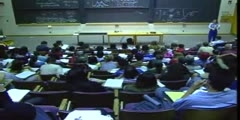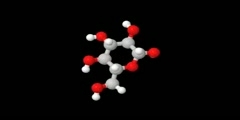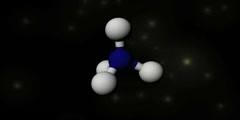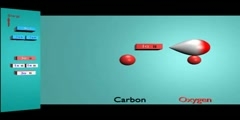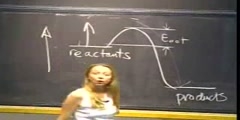Lec 23 - Valence Theory and Constitutional Structure (1858)
"Lec 23 - Valence Theory and Constitutional Structure (1858)" Freshman Organic Chemistry (CHEM 125) Youthful chemists Couper and Kekulé replaced radical and type theories with a new approach involving atomic valence and molecular structure, and based on the tetravalence and self-linking of carbon. Valence structures offered the first explanation for isomerism, and led to the invention of nomenclature, notation, and molecular models closely related to those in use today. 00:00 - Chapter 1. Archibald Couper: "Look to the Elements" 10:25 - Chapter 2. Tetravalence and Self-Linking of Carbon 19:39 - Chapter 3. Kekule's Advancements in Chemical and Molecular Notation 38:32 - Chapter 4. 3-D Molecular Models: From Brass Strips to Croquet-Balls Complete course materials are available at the Open Yale Courses website: http://open.yale.edu/courses This course was recorded in Fall 2008.
Video is embedded from external source so embedding is not available.
Video is embedded from external source so download is not available.
Channels: Chemistry (General)
Tags: Isomers Kekulé Couper Molecular Models Nomanclature
Uploaded by: yalefreshorganic ( Send Message ) on 05-09-2012.
Duration: 48m 47s
Here is the next lecture for this course
Lec 25 - Models in 3D Space (1869-1877); ...
49:02 | 3443 viewsChemical Science - Molecular Orbital Theo ...
50:51 | 32508 viewsThe valence bond theory
49:54 | 23948 viewsLec 24 - Stereoisomers, Enantiomers, Dias ...
13:36 | 4392 viewsLec 10 - Molecular Structure and Geometry
02:00 | 2862 viewsMolecular structure of glucose
00:26 | 20679 viewsValence shell electron pair repulsion theory
03:20 | 17086 viewsChemical Science - The Shapes of Molecule ...
43:18 | 31954 viewsWhat is Orbital Molecular Theory
05:20 | 7915 viewsLec 27 - Communicating Molecular Structur ...
51:36 | 3468 viewsLec 35 - Understanding Molecular Structur ...
48:42 | 4163 viewsLec 14 - Checking Hybridization Theory wi ...
47:36 | 3558 viewsChemical Science-Atomic Theory of Matter ...
41:59 | 31633 viewsChemical Science - Breakdown of Octet Rul ...
50:10 | 18737 viewsLecture on molecular biology: DNA
43:12 | 24468 viewsNo content is added to this lecture.
This video is a part of a lecture series from of Yale
Lecture list for this course
Lec 2 - Force Laws, Lewis Structures and Resonance
Lec 3 - Double Minima, Earnshaw's Theorem and Plum-Puddings
Lec 4 - Coping with Smallness and Scanning Probe Microscopy
Lec 6 - Seeing Bonds by Electron Difference Density
Lec 7 - Quantum Mechanical Kinetic Energy
Lec 8 - One-Dimensional Wave Functions
Lec 9 - Chladni Figures and One-Electron Atoms
Lec 10 - Reality and the Orbital Approximation
Lec 11 - Orbital Correction and Plum-Pudding Molecules
Lec 12 - Overlap and Atom-Pair Bonds
Lec 13 - Overlap and Energy-Match
Lec 14 - Checking Hybridization Theory with XH_3
Lec 15 - Chemical Reactivity: SOMO, HOMO, and LUMO
Lec 16 - Recognizing Functional Groups
Lec 17 - Reaction Analogies and Carbonyl Reactivity
Lec 18 - Amide, Carboxylic Acid and Alkyl Lithium
Lec 19 - Oxygen and the Chemical Revolution (Beginning to 1789)
Lec 20 - Rise of the Atomic Theory (1790-1805)
Lec 21 - Berzelius to Liebig and Wöhler (1805-1832)
Lec 22 - Radical and Type Theories (1832-1850)
Lec 24 - Determining Chemical Structure by Isomer Counting (1869)
Lec 25 - Models in 3D Space (1869-1877); Optical Isomers
Lec 26 - Van't Hoff's Tetrahedral Carbon and Chirality
Lec 27 - Communicating Molecular Structure in Diagrams and Words
Lec 28 - Stereochemical Nomenclature; Racemization and Resolution
Lec 29 - Preparing Single Enantiomers and the Mechanism of Optical Rotation
Lec 30 - Esomeprazole as an Example of Drug Testing and Usage
Lec 31 - Preparing Single Enantiomers and Conformational Energy
Lec 32 - Stereotopicity and Baeyer Strain Theory
Lec 33 - Conformational Energy and Molecular Mechanics
Lec 34 - Sharpless Oxidation Catalysts and the Conformation of Cycloalkanes
Lec 35 - Understanding Molecular Structure and Energy through Standard Bonds
Lec 36 - Bond Energies, the Boltzmann Factor and Entropy
Lec Last - Potential Energy Surfaces, Transition State Theory and Reaction Mechanism


